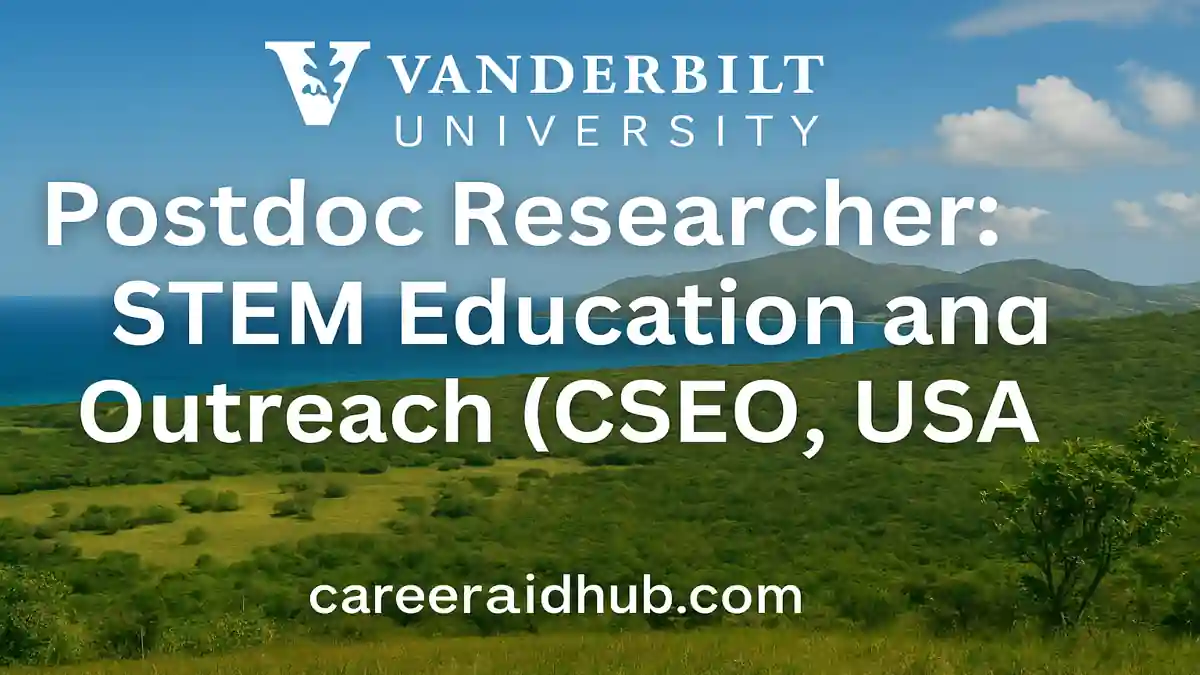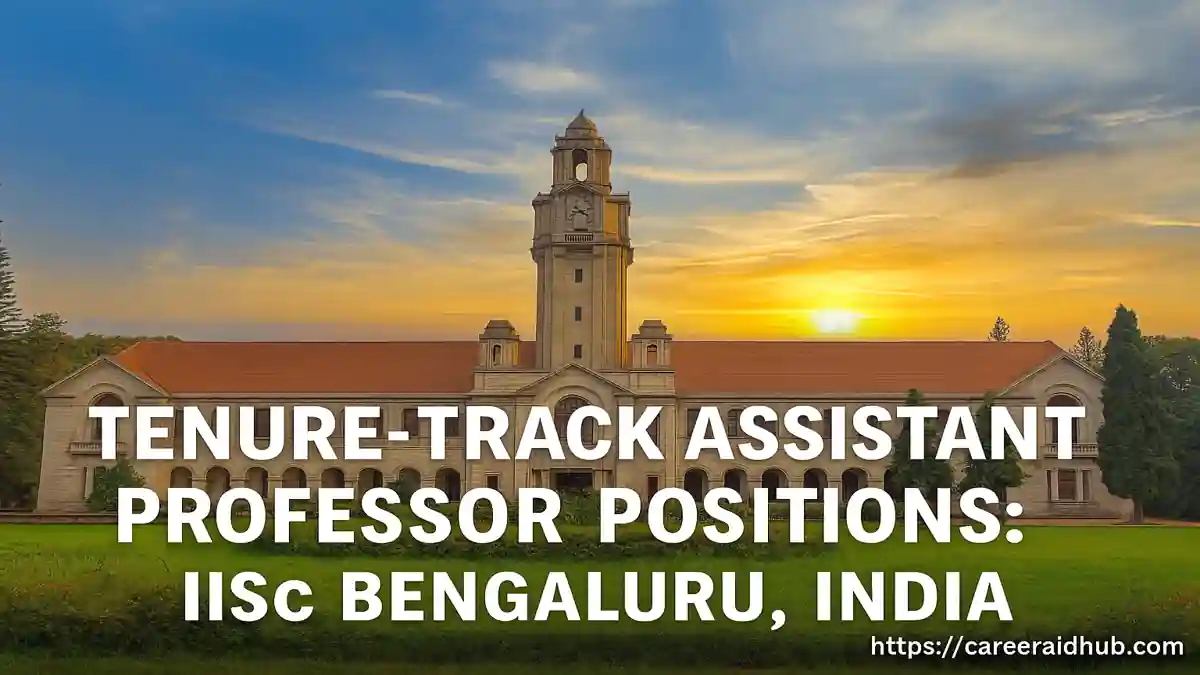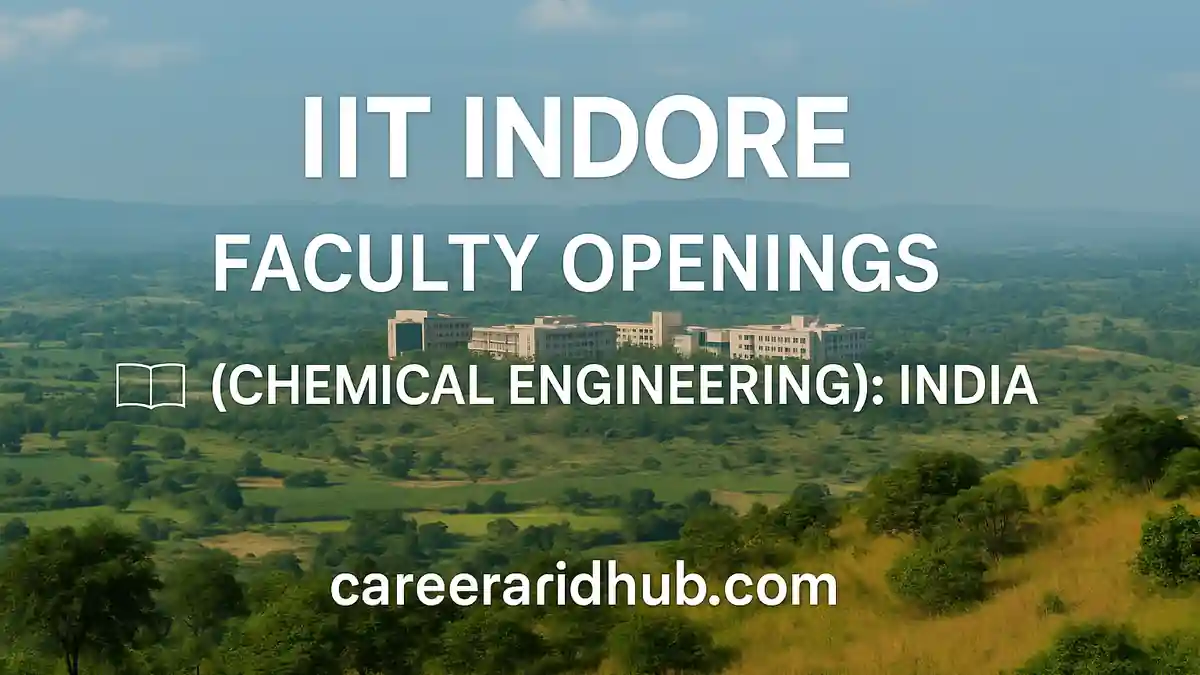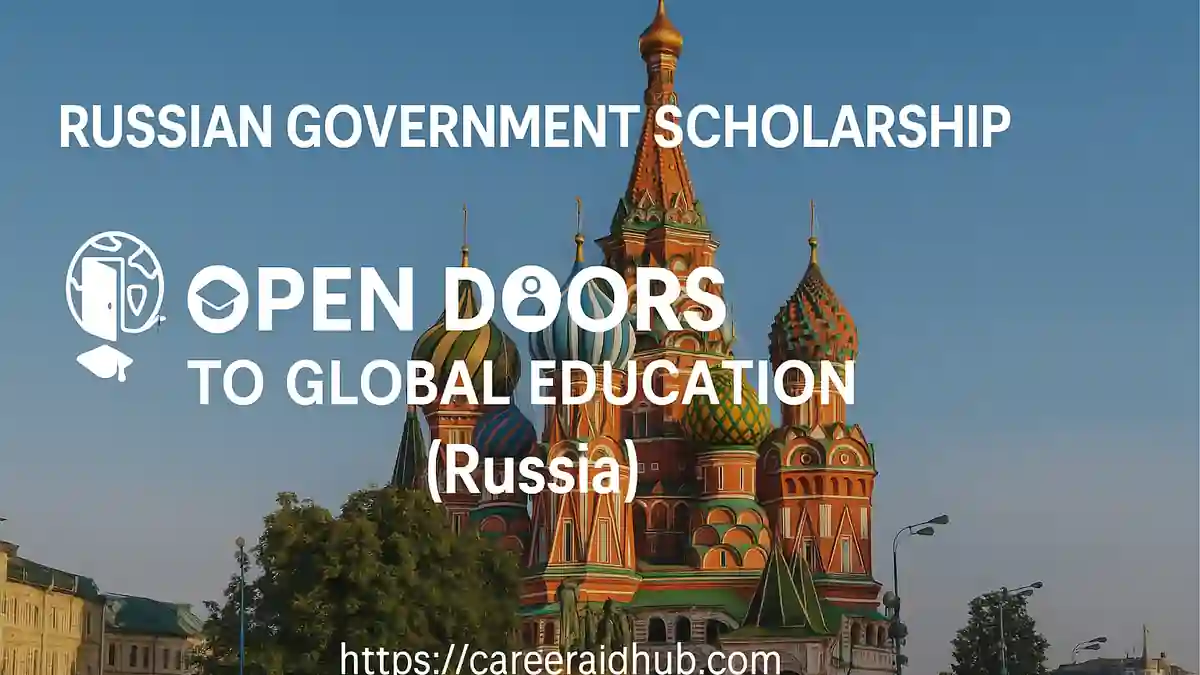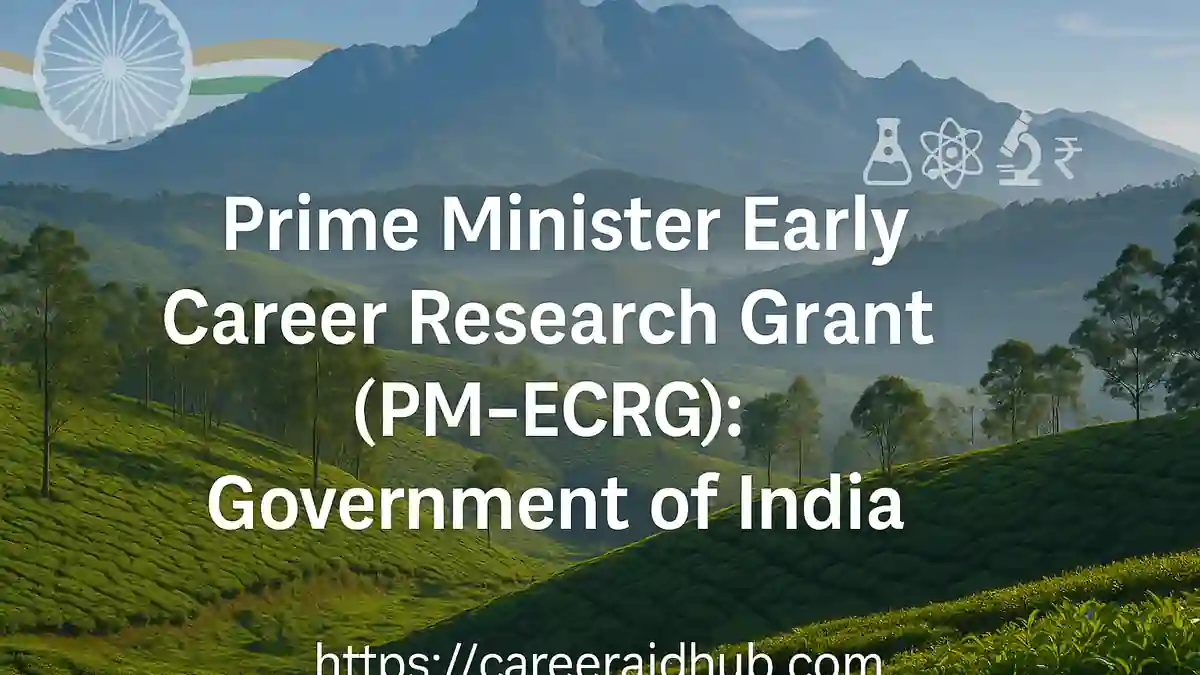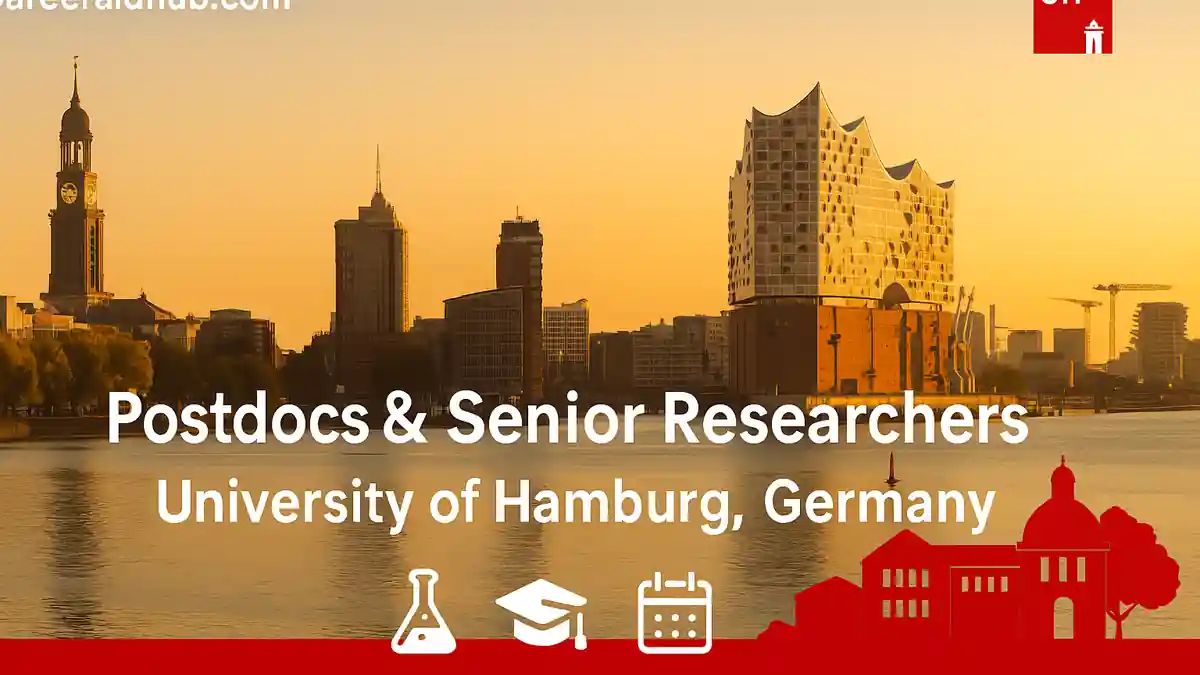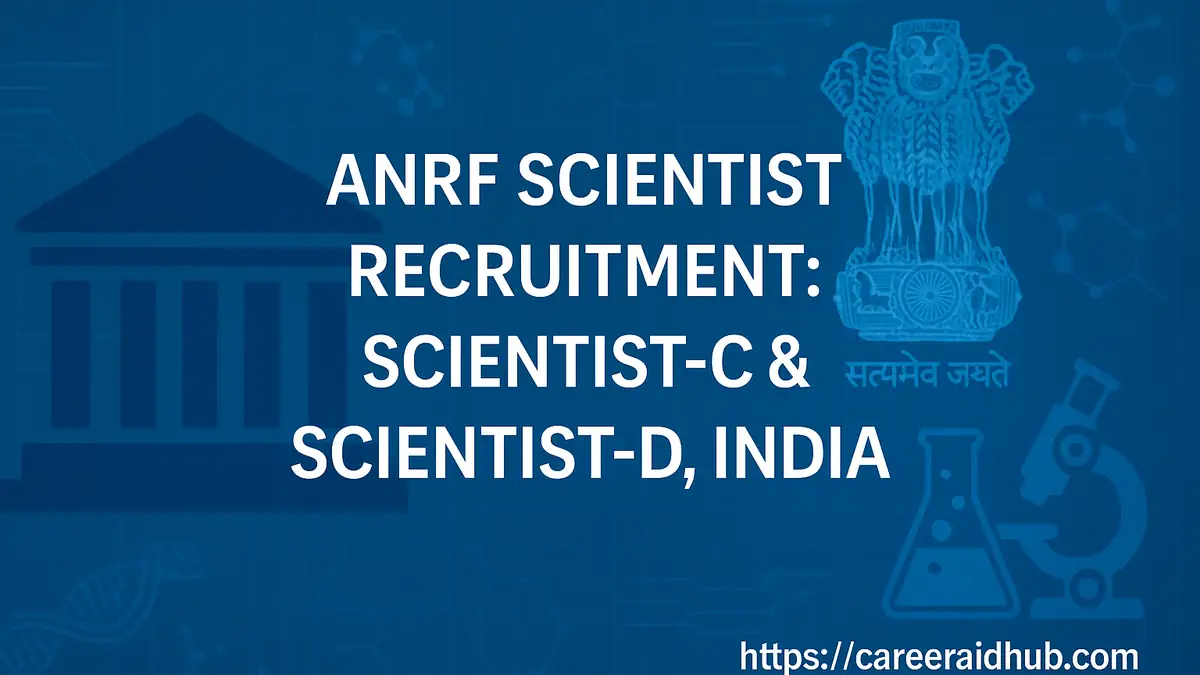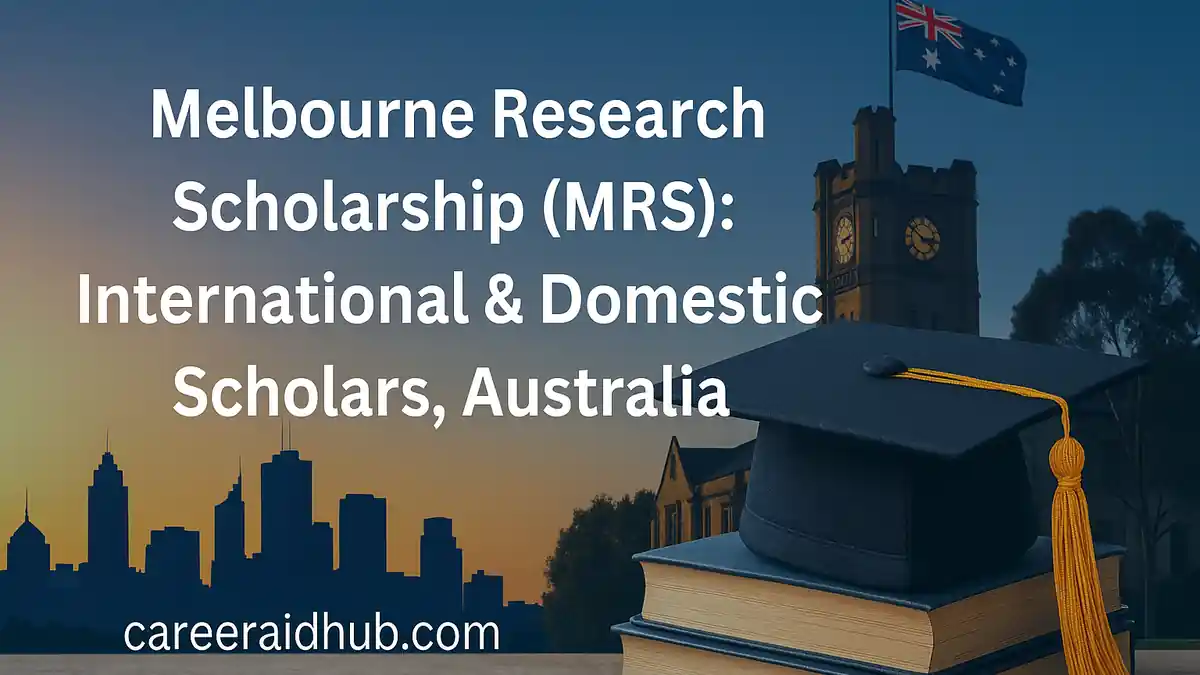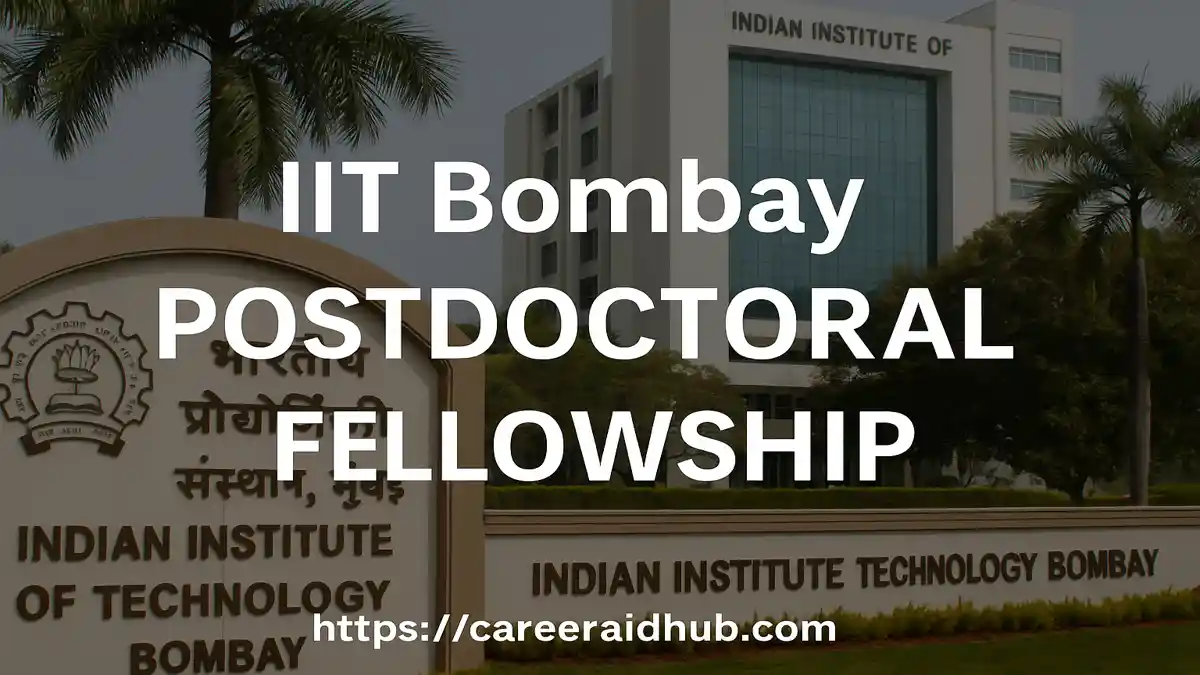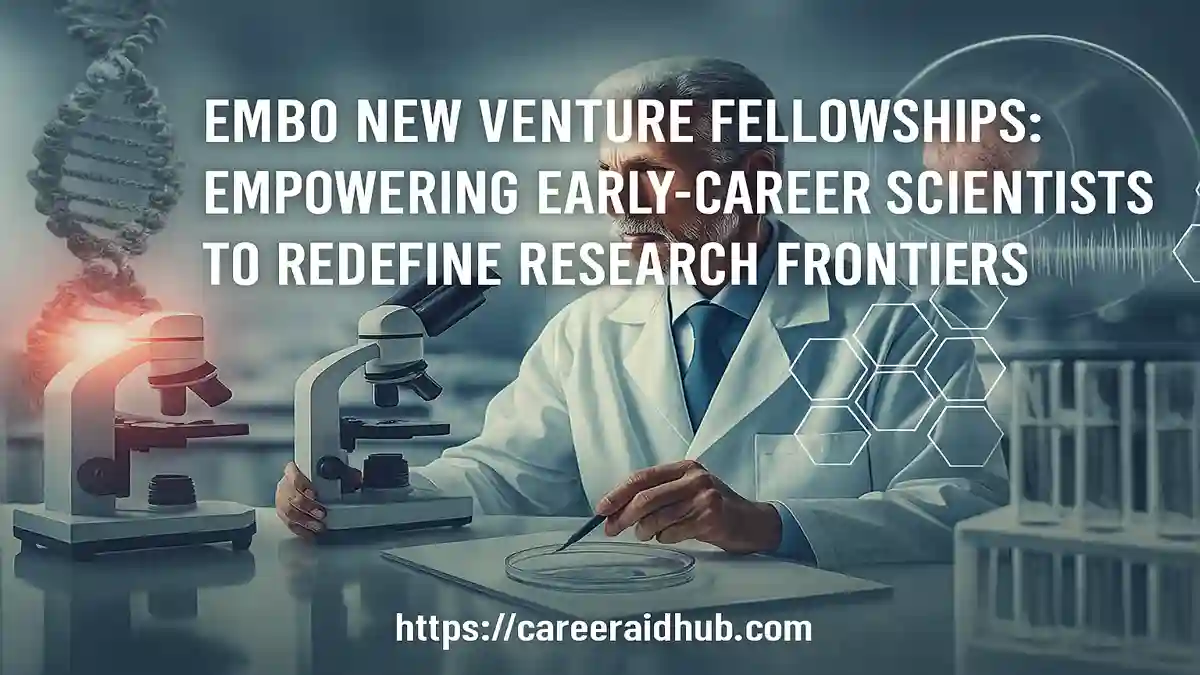Postdoctoral Researcher – Collaborative for STEM Education and Outreach (CSEO), Vanderbilt University (STEM & K–12 Outreach Role)
Vanderbilt University, through its Collaborative for STEM Education and Outreach (CSEO) in the Department of Teaching and Learning at Peabody College of Education and Human Development, is inviting applications for a practice-oriented, research-informed postdoctoral position that directly supports K–12 STEM learning, teacher capacity-building, and student research experiences in both Nashville and the U.S. Virgin Island of St. Croix. This role is particularly suitable for STEM Ph.D. graduates who want their disciplinary training to translate into educational impact, not remain confined to the laboratory or to theoretical work.
In contrast to conventional postdoctoral roles that emphasize only publication or disciplinary research, this opportunity sits deliberately at the intersection of STEM content, education innovation, and community partnership. Consequently, the appointee will work with high school students, science and mathematics teachers, and Vanderbilt’s long-running outreach programs to help learners gain the skills, confidence, and pathways needed to pursue higher education in STEM.
A fully funded postdoctoral position is open at Vanderbilt University’s Collaborative for STEM Education and Outreach (CSEO) in the Department of Teaching and
Learning, Peabody College. The role targets STEM Ph.D. graduates keen to convert disciplinary expertise into high-impact K–12 STEM learning in Nashville and St. Croix.
To make the article fully indexable and AdSense-compliant, the following sections retain the original structure while expanding explanation, adding subheadings for readability, and integrating natural long-tail search phrases such as “postdoctoral positions in STEM education,” “Vanderbilt Peabody postdoc,” “K–12 STEM curriculum development fellowships,” and “STEM outreach in U.S. territories.”
1. Overview of the Opportunity
This postdoctoral research position has been structured for candidates who already possess deep STEM disciplinary knowledge—for example, in physics, engineering, applied mathematics, computational science, or data-intensive STEM—and who now wish to apply that expertise to real school settings.
1.1 Dual-Location, High-Impact Role
Unlike many campus-bound postdocs, this role has a dual focus:
On-site engagement in St. Croix with a STEM magnet high school and local educators.
Program development and collaboration at Vanderbilt University in Nashville alongside CSEO and the Department of Teaching and Learning.
Because of this dual structure, the postdoc will support a new STEM education initiative in St. Croix
1.2 Purpose and Rationale
The core aim of the postdoc is to raise the level of STEM learning—especially computation-heavy and mathematically intensive STEM—among high school students so that they can realistically enroll in science, engineering, and data-related majors in college. Because St. Croix is a territory setting and not a mainland U.S. district, the position also has a capacity-building and equity dimension: the fellow will help local teachers deliver inquiry-based STEM instruction that aligns with what strong college-preparatory programs expect.
1.3 Candidate Profile at a Glance
Ph.D. completed or near completion in a STEM, engineering, or computational discipline.
Genuine interest in K–12 STEM outreach, not just higher education teaching.
Willingness to co-develop curricula with teachers rather than imposing an external model.
Readiness to travel and work in a community-engaged, place-based project.
2. About CSEO and Peabody
Vanderbilt University’s Collaborative for STEM Education and Outreach (CSEO) has a long track record of running high-visibility, high-rigor STEM programs for
2.1 Flagship K–12 Initiatives
CSEO is widely recognized for:
Interdisciplinary Science and Research (ISR) Program – which pairs students with mentors to conduct meaningful, long-term research projects.
School for Science and Math at Vanderbilt (SSMV) – a selective program providing advanced STEM instruction to talented students.
Day of Discovery (DoD) – structured, experiential STEM learning designed to spark interest and connect learning to real-world problems.
These programs are built around inquiry-based, project-based, and student-centered pedagogies. Instead of passive learning, students are encouraged to ask questions, design investigations, analyze data, and present their findings.
2.2 Relevance to the St. Croix Initiative
The new St. Croix partnership will mirror this established philosophy but will dial up the emphasis on:
Computational thinking
Mathematically intensive STEM modules
Engineering design and problem solving
Authentic research experiences for high school students
Because the students in St. Croix must compete for places in U.S. and global
2.3 Cross-Unit Collaboration
The postdoc will also have opportunities to connect with:
Programs for Talented Youth (PTY) at Vanderbilt
Other Peabody research and outreach initiatives
Faculty members working on STEM teaching, learning sciences, and equity in education
This makes the position well suited for scholars who want to build a career in STEM education leadership, curriculum and instruction, or STEM-focused centers within universities.
3. What You Will Do
This position is expressly not a “sit-in-the-lab-and-publish-only” role. It is a practice-facing, education-impact postdoc in which the scholar will be highly visible to K–12 partners.
3.1 Core Instructional and Curriculum Functions
The postdoctoral researcher will:
Design and deliver inquiry-based STEM curricula in physics, engineering, mathematics, and data/computation-heavy topics suited to advanced high school learners.
Guide high school student research projects so that learners gain authentic exposure to the practice of science and engineering—data collection, hypothesis refinement, modeling, and presentation.
Work directly with teachers in St. Croix to co-develop and adapt content to local needs, assessment systems, and student backgrounds.
Support after-school or enrichment clubs that maintain STEM interest beyond classroom hours and help students build STEM portfolios.
Because the program involves students from underrepresented or geographically distant regions, the postdoc will also model college-going and STEM-career pathways, showing students what undergraduate, graduate, and research careers in STEM can look like.
3.2 Program-Building and Partnership Work
In addition to classroom-facing duties, the fellow will help build and sustain relationships with:
Vanderbilt departments and outreach units
Community and school partners in St. Croix
Program sponsors and stakeholders
This work is critical for scaling and sustaining the initiative so that it outlives the single-year appointment.
3.3 Space for Scholarly Growth
The position also leaves deliberate space for scholarly and professional growth. Depending on the candidate’s experience and interests, they may:
Participate in program evaluation or mixed-methods research on STEM outreach;
Co-author practitioner or academic papers with Vanderbilt faculty;
Contribute to grant-funded STEM education projects.
Thus, the role is an excellent bridge for a STEM Ph.D. who wants to pivot into STEM education research, work in a school of education, or eventually lead a pre-college STEM center.
4. Who Should Apply
This section of the original announcement is especially important because it defines what Vanderbilt considers a “good fit.” The university is very clear that it wants someone with strong disciplinary training who is willing to extend that training into K–12 education.
4.1 Academic Background
A Ph.D. is required. Fields may include physics, applied mathematics, engineering (mechanical, electrical, civil, or interdisciplinary), computer science, computational science, or another STEM area with substantial quantitative or data-driven components.
Candidates whose doctoral work involved modeling, simulation, or data analysis will be adept at developing higher-order learning tasks for high school students.
Applicants with prior K–12 STEM education experience—curriculum writing, teacher professional development, science fair mentoring, robotics clubs, coding or maker clubs—will have an advantage, but this experience is preferred, not mandatory.
4.2 Dispositions and Competencies
Beyond academic credentials, Vanderbilt is looking for a postdoc who:
Is willing to spend extended periods in St. Croix and appreciates the importance of place-based, community-engaged education;
Respects and collaborates with local teachers rather than imposing a top-down approach;
Can translate abstract STEM concepts into accessible, inquiry-oriented classroom experiences;
Is comfortable working in multicultural, multi-site educational environments.
If you are excited by STEM capacity building in island or territory contexts, or if you wish to position yourself for future roles in broadening participation in STEM (BPS), equity in STEM, or NSF-funded outreach, this is a highly strategic postdoc.
5. Why This Postdoc Is Special
Most postdoctoral opportunities in STEM education fall into one of two categories:
Research-heavy, classroom-light positions in schools or colleges of education; or
Teaching- or PD-heavy roles with little time for research, publication, or program design.
Vanderbilt’s postdoctoral role is unusual because it integrates the best features of both.
5.1 Practice + Research Integration
You will see learners and teachers actually use the curriculum and tools you help create.
You will be backed by institutional support from a consistently top-ranked U.S. education school, Peabody College.
You will contribute to a regional impact initiative in the U.S. Virgin Islands, which is not a saturated educational market and therefore offers high marginal impact.
You will work under a “specialized growth plan” that can be tailored to your anticipated career path—whether faculty, director of outreach, STEM education consultant, or education PI.
5.2 Career Trajectory Advantages
For STEM Ph.D.s who wish to build a portfolio that appeals to:
STEM education faculty search committees,
Directors of pre-college or outreach centers,
Leaders of university–school STEM partnerships, or
PIs/Co-PIs on NSF STEM education, ITEST, or broadening participation projects,
this is exactly the kind of role that provides both credibility and evidence of impact.
5.3 Added SEO/Backlink Potential for Your Site
From a content-publishing perspective (if you are posting this on your academic or opportunity portal), this section is also an opportunity to insert expert insights and actionable tips such as:
How to position your STEM Ph.D. for K–12-oriented postdocs;
How to discuss community-engaged research in a cover letter;
What to emphasize when you lack formal teacher education experience.
These sub-parts make the article linkable and can attract backlinks from university career offices, STEM teacher networks, and education bloggers.
6. Appointment Terms and Support
The appointment terms are straightforward, but they are also competitive compared to many education-facing fellowships.
6.1 Duration and Renewal
The postdoc is initially for 12 months.
Extension is possible depending on performance, project continuation, and funding availability.
Because the project serves a real partner school and involves on-site implementation, Vanderbilt has an interest in maintaining continuity; hence, strong postdocs may reasonably expect discussions about renewal.
6.2 Compensation and Benefits
The position includes salary commensurate with Vanderbilt’s postdoctoral scales.
Health insurance coverage is provided.
Travel, local transportation, lodging, and per diem/meal support for St. Croix visits will be covered by the project, making the cost of extended fieldwork manageable for the postdoc.
A professional growth plan may support attendance at education or STEM conferences.
6.3 Application Review Timeline
Vanderbilt has indicated that review of applications will begin immediately and will continue until the position is filled. This effectively means that the recruitment is rolling. Because such roles can be filled quickly once a suitable candidate applies, early submission is strongly advised.
For future cycles, based on typical U.S. academic hiring patterns, prospective applicants should look for updated calls around January 2026 and again around May–June 2026 – we will update soon.
7. How to Apply
The application procedure is intentionally simple and direct.
7.1 Submission Channel
Applications must be submitted by email to:
Dr. Angela Eeds
Email: [email protected]
Subject line: “CSEO STX Postdoctoral Fellow Search.”
A precise subject line helps the project team to route applications quickly.
7.2 Application Package
Your email should include the following four components:
Letter of Interest
Explain your STEM disciplinary background (e.g., physics, engineering, mathematics, computational science).
Describe your experience, if any, with K–12 education, outreach, curriculum development, or teacher partnerships.
Explicitly state your readiness to work on site in St. Croix and your interest in community-engaged STEM.
One Publication or Manuscript in Progress
This may be a peer-reviewed article, a dissertation chapter showing your analytical ability, or a manuscript that demonstrates your capacity to write for scholarly or practitioner audiences.
Current Curriculum Vitae (CV)
List education, appointments, fellowships, teaching, outreach, publications, and relevant STEM grants or projects.
Names and Contact Information for Three References
Preferably include them in the letter/body to streamline review.
7.3 Additional Due Diligence
Prospective applicants are encouraged to study:
The CSEO page to understand program models and target populations;
The Peabody College website to see how STEM education, teacher learning, and outreach are positioned in the college;
Vanderbilt’s Office of Postdoctoral Affairs pages for policies and benefits.
This background reading allows you to write a situated, Vanderbilt-specific cover letter rather than a generic one.
8. Final Takeaway
If you are a STEM Ph.D. who wants your expertise to matter immediately—in classrooms, in teacher professional learning, and in the higher-education choices of high school students—this Vanderbilt postdoctoral role deserves serious consideration. It combines international/territory-based fieldwork (St. Croix), rigorous STEM curriculum design, K–12 partnership building, and academic visibility in one appointment.
To present yourself as a strong candidate, make sure your application clearly shows:
Your computational, mathematical, engineering, or data-intensive STEM strength; and
Your commitment to co-designing with local teachers and working on-site in St. Croix.
Applicants who can demonstrate both content depth and educational adaptability will align best with Vanderbilt’s expectations.
Suggested Update Cycle
Review every 3 months (January, April, July, October) for deadline, eligibility, and funding updates.
Mark clearly at the top of your live post: “Last updated: Month, Year.”
Monitor the official Vanderbilt page for wording changes, as universities occasionally adjust language regarding travel support, remote participation, or DEI expectations.
Conclusion
This postdoctoral research position at Vanderbilt University’s CSEO stands out because it offers STEM Ph.D. holders a genuine opportunity to operate at the nexus of disciplinary science, K–12 education, and community-engaged outreach. It is ideal for individuals who want to build a career in STEM education leadership, school–university partnership programs, or pre-college STEM initiatives and who are prepared to work in a dual-location, high-contact environment that directly benefits students in St. Croix and Nashville. Interested candidates should apply early, tailor their letter to CSEO’s mission, and emphasize both their STEM depth and their readiness for field engagement.
Call to Action:
Prepare your four-part application package, confirm your availability for travel, and write a Vanderbilt-specific statement of interest. Then email [email protected] with the subject line “CSEO STX Postdoctoral Fellow Search.” Early, well-targeted applications are more likely to be reviewed favorably.
At a Glance (Program Snapshot)
| Feature | Details |
|---|---|
| Program Name | Postdoctoral Researcher – Collaborative for STEM Education and Outreach (CSEO), Department of Teaching and Learning, Peabody College, Vanderbilt University |
| Host Country | United States – primarily Nashville, Tennessee, with field engagement in St. Croix, U.S. Virgin Islands |
| Funded By | Vanderbilt University / Peabody College of Education and Human Development |
| Duration | 12 months, with possibility of renewal/extension based on performance and funding |
| Study | Full-time, campus-based with required field visits to St. Croix (travel, lodging, and meals supported) |
| Eligibility | Ph.D. in physics, mathematics, engineering, or a closely related computational/data-intensive STEM field; interest in K–12 STEM education and curriculum design |
| Financial Support | Salary + health insurance; travel and accommodation support for St. Croix visits; professional growth plan |
| Fields of Work | STEM Education, K–12 Outreach, Curriculum & Research Project Design, Teacher Capacity Building, Community-Engaged STEM |
| Deadline | Rolling, from October 2025; next review cycle expected January 2026 – we will update soon |
| Website | Click Here |
Frequently Asked Questions
It is a full-time postdoctoral role to design, deliver, and evaluate K–12 STEM education programs in Nashville and St. Croix in collaboration with Vanderbilt’s CSEO.
Applicants must hold a Ph.D. in physics, mathematics, engineering, computer science, or a related computational STEM field and be interested in K–12 STEM education.
No, but experience in outreach, curriculum development, STEM clubs, or teacher collaboration will strengthen your application and will help you work effectively with schools.
Yes, the role requires on-site work in St. Croix to support a STEM magnet high school. However, Vanderbilt will support travel, stay, and meal expenses.
You will co-create inquiry-based STEM lessons, mentor student research, run enrichment activities, and help teachers implement rigorous, computation-rich STEM modules.
No, it is a practice-oriented postdoc. You will blend STEM education delivery, program development, and, where appropriate, education research or evaluation activities.
The initial appointment is for 12 months. However, Vanderbilt may extend it based on performance, program needs, and funding availability.
You should email Dr. Angela Eeds with a letter of interest, CV, one publication or manuscript, and contact details of three referees using the subject line provided.
Yes, the postdoctoral position includes salary, health insurance, and supported travel to St. Croix, making it financially feasible for early-career scholars.
Because it links STEM expertise with real K–12 impact, it prepares you for roles in STEM education leadership, outreach centers, university–school partnerships, and funded education projects.

